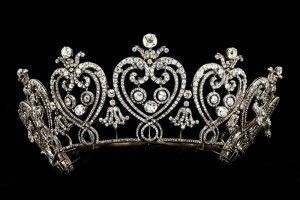Dressed in Diamonds: American Princesses and Gilded Age Fashion
Kevin L. Jones, Fashion Institute of Design and Merchandising Museum

Manchester Diamond Tiara, Cartier, 1903. Victoria and Albert Museum.

“At the Opera,” Charles Dana Gibson, 1904. Private Collection.
In February 1890, the fictional Cora Levinson of Cincinnati wed Robert Crawley, the fictional 7th Earl of Grantham. Cora brought her American dry-goods fortune to the marriage and was able to save the the Grantham’s Downton Abbey estate. Cora is the embodiment of an American Dollar Princess.
The time-period between the end of the Civil War in 1865 and the beginning of World War I in 1914 is known as “The Gilded Age,” a term popularized by prolific writer and social-commentator Mark Twain. Twain’s visionary insight revealed that America’s desire for all things modern and industrial was at odds with its undemocratic nostalgia for class hierarchy and aristocratic bearing. Social distinctions between the “Old World” and the “New” were lessened by those few who were able to harness this fierce industrial era in which an uneducated nobody could become a respected somebody through sheer hard work, luck, and a “public-be-damned” attitude.
The veneer that separated Yankee worker from European gentleman was thin, but the Industrial Revolution’s greatest asset—money—helped to gild American and re-gild European societies. And, for the most part, this highly reflective gloss was applied with layers of elaborate dresses and overlapping jewels worn by the “Dollar Princess” daughters of these “Robber Barons.” Five of these Dollar Princesses are profiled in this lecture: Jennie Jerome, later Lady Randolph Churchill; Consuelo Yznaga, later Duchess of Manchester; Consuelo Vanderbilt, later Duchess of Marlborough; Helena Zimmerman, later Countess of Kintore; and May Goelet, later Duchess of Roxburghe.
Kevin Jones is curator of the FIDM Museum at the Fashion Institute of Design & Merchandising, Los Angeles. He studied fashion design at the Fashion Institute of Design & Merchandising and art history at the University of California, Santa Barbara. Kevin joined the FIDM Museum as collections manager in 1999, and was appointed curator in 2002. Kevin’s diverse exhibitions cover Hollywood to high fashion. In 2009, he co-curated the Richard Martin Award-winning exhibition, catalogue, and documentary High Style: Betsy Bloomingdale and the Haute Couture. *Additionally, Kevin co-curated *FABULOUS! Ten Years of FIDM Museum Acquisitions, 2000–2010, and co-authored the accompanying 380-page catalogue, which covers fashion history from 1800 to 2010. Kevin often presents papers at academic symposia and is sought after for interviews in newspapers and magazines, and on radio and television. His exhibition and catalogue Sporting Fashion: Outdoor Girls 1800 to 1960 was to open at the FIDM Museum in May 2020. It will tour the United States through 2023. Currently, he is developing a long-term project titled Gilding the Lily: American Women and Paris Fashion, 1860s to 1910s. Also, Kevin is in continual research for his “retirement” book First Class: Titanic’s Women of Fashion. Among his professional associations, Kevin is a member of the Costume Society of America, the Titanic Historical Society, and the Preservation Society of Newport, Rhode Island.